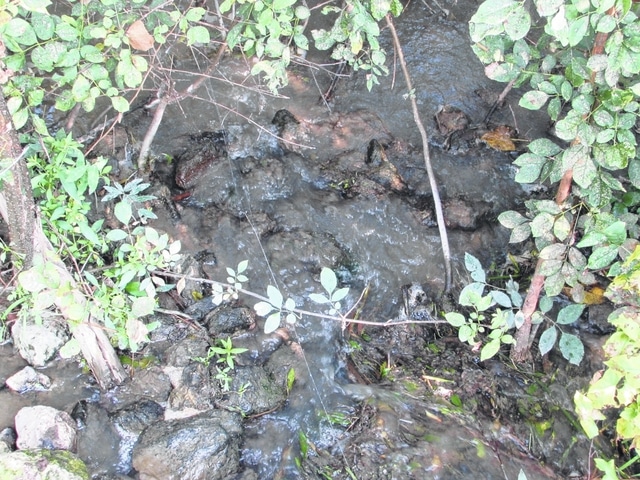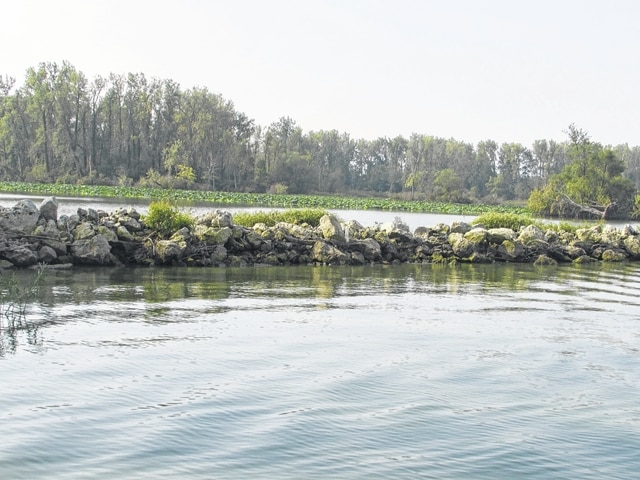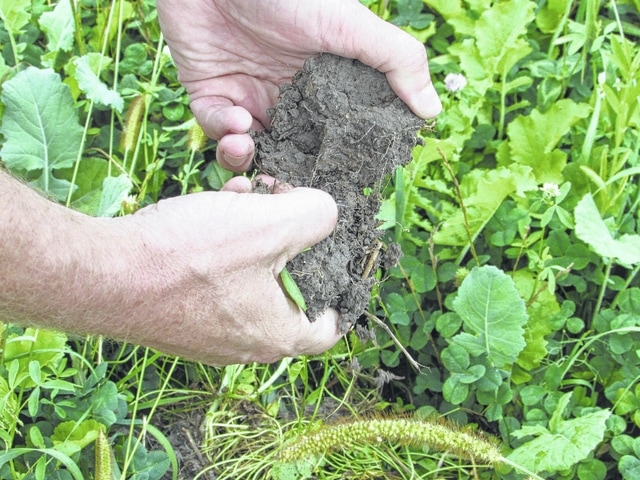


CELINA — Area settlers probably had no idea of the controversy that awaited nearly 180 years later.
Created to serve as a reservoir for the Miami-Erie Canal System in 1837, Grand Lake has grabbed headlines for all the wrong reasons as toxicity levels have been causing problems since 2008, affecting water quality, a $200 million tourism industry, home values in proximity to the watershed, and a host of other problems. While there is an overwhelming consensus that something needs to be done, the agreement stops at that point.
The Grand Lake water crisis has been brought on by a number of conditions during the past decades, including nutrient runoff, the elimination of natural banks, industrial and residential drainage, and shallow lake depth.
Three organizations, the Lake Improvement Association, the Grand Lake Restoration Commission, and the Guardians of Grand Lake St. Marys have exhaustively spent time and money trying to fix the problem. Town meetings, cleaning projects, science research and public education are just some of the many ways used to address the issue.
What causes the problem?
Toxic algae blooms are caused by an abundance of nutrients in warm, slow-moving water that lead to the overpopulation of algae, specifically algae of the type that releases harmful toxins. In the summer of 2010, Grand Lake experienced four separate toxins caused by two types of blue-green algae: Microcystis, which produces the toxin microcystin; and aphanizomenon, which produces the toxins cylindrospermopsin, saxitoxin, and anatoxin.
In actuality, blue-green algae isn’t algae at all. It is cyanobacteria. This bacteria looks like algae and its blooms look green, or bluish-green. The toxin is known to cause many health problems, including allergic reactions, liver damage, cancer, liver failure, internal hemorrhaging, heart and kidney and other internal organ damage and failure, paralytic shellfish poisoning, paralysis, loss of coordination, convulsions, respiratory distress and failure, and even death.
The one thing most local organizations agree on is the majority of the problem is caused by nutrient runoff from the agricultural industry. The phosphorus runoff from area farms has been such a problem farmers in the lake’s watershed now face state-mandated limits on the manure they spread on fields. Many scientific studies have shown that at least 50 percent of the fields were over-saturated with phosphorus. The blue-green algae feeds off the nutrient-rich runoff feeding into the lake from its tributaries such as Prairie, Coldwater, Beaver, Barnes, Big Chickasaw and Little Chickasaw creeks.
Just how big is the problem?
The World Health Organization has set the standard for toxicity of a water body at 20 parts per billion, saying warnings or other public announcements should be made when that number is exceeded.
To put it in perspective, the city of Celina purchased a multimillion-dollar water treatment plant because it uses the water for its utilities. Water is tested regularly at the Celina public water system intake. In June, despite all the efforts made to improve the lake, the water tested at 161 parts per billion, more than eight times the WHO guideline and the highest measurement since the tests began in January 2011.
One project showing limited results
The Lake Improvement Association formed soon after the onset of problems to promote closer fellowship and cooperation among farmers, landing owners and park operators, and to advance the general improvement of the lake, its shores, channels, creeks, landings, parks and land in order to promote good health, soil stability, and clean, wholesome recreation for public and private use.
To try and make a difference, the association put together the Grand lake Restoration Commission. The organization’s first major undertaking is showing results that are opening some eyes with the Prairie Creek Treatment Train.
Commission Manager Milt Miller said the treatment train is basically a “natural water treatment plant.”
About 1.3 million gallons of water are pumped each day from Prairie Creek and ran through a natural filtering system of deep pool water and vegetation to capture the nutrients before it gets to the lake. The slow-moving water drops the silt in the pools and the vegetation uses up the nutrients.
The result has not only revealed cleaner water, but the area now serves as a nature reserve and wetlands. The area appeared to almost be in its original state, a swamp land teaming with frogs, snakes and waterfowl. The biggest revelation was at the end of the train. Water going through the end of the treatment train was as clear as can be. While the water has a small area of tree line to reach the lake, Miller showed where natural vegetation is exploding out into the lake, showing proof of its success.
Miller said there are several setbacks.
While 1.3 million gallons from one creek may sound like a lot, it is a fraction of the water that empties into Grand Lake. The project was expensive, and the commission receives only donations and has not received state or federal funds. It leads to questions of cost-effectiveness. Much of the land purchased for the treatment train was high-priced farmland. The organization must also compete with real estate and other development around the lake.
Still, Miller said it is a step in the right direction.
“It is just one of the many pieces of the puzzle,” Miller said. “It isn’t a solution that will fix the lake all by itself, but there is a lot of standing around and finger-pointing. We felt like we had to do something.”
The project has been so successful that two other projects are in various stages of preparation on Coldwater and Beaver creeks. Miller said the shut down of the water supply in Toledo because of problems on Lake Erie have put more focus on the issue. Universities and other study groups are clamoring to set up monitoring stations at the treatment train.
Guardians of the Lake taking a matter-of-fact approach
The Guardians of the Lake have become unpopular with some because of its stance on the lake. However, Bill Ringo, a member of the organization, said it is a problem that requires a solid stance.
The group has focused its efforts on cleaning up the lake by pointing a finger at unclean, unsafe farming practices in the watershed. Members have routinely shown up at public meetings for livestock expansions on farms to challenge them.
The group said residents in Auglaize and Mercer counties have been waiting for nearly two decades for the state of Ohio to clean up the lake. They said the state has had the tools to clean up the lake with the “Total Maximum Daily Load” plan, which specifically spells out that about 90 percent to 100 percent of all phosphorous, nitrates and fecal coliform should be stopped from coming into Grand Lake if there is any hope of cleaning up the lake. The maximum daily load plan would put heavy restrictions on farmers using nutrients.
Its position naturally has been met with scrutiny from farmers in one of the most prominent agricultural regions in the nation.
Ringo said that while stricter practices would likely result in higher costs on food, it is a price worth paying.
“I would gladly pay more if it meant less harm to the environment,” Ringo said. “Wouldn’t you?”
Ringo said the problem is easy to see. In 1964, the total pig, cattle and calf inventory in Mercer and Auglaize counties was 194,000. By 2002, that number was 294,000. The number exploded even more, by 77 percent in 2011 to 520,000. The group said that the timing of algae problem and livestock population explosion “is not a coincidence.”
The Guardians has been critical of Gov. John Kasich, saying he has broken campaign promises of addressing the issue.
Area farmer says he has the answer
Jeff Rasawehr said the problem lies solely in the biological shape of the soil in the area.
Rasawehr has become a keynote speaker almost weekly both nationally and internationally when it comes to soil health. On his farm on Kuck Road in Mercer County, he showed an experiment of his farmland as compared to farmland relying predominantly on more conventional chemical and industrial farming. The soil from his farm stayed intact when doused with water, while farmland with chemical applicants literally turned to mud. He said that leads to nutrients being washed away easily.
Rasawehr said his efforts maximize the utilization of the nutrients, and minimizes or mitigates nutrient discharge into the environment. He has mixed that practice with diversified cover cropping and rotating to maximize his farmland’s health.
Rasawehr said the problem could be quickly fixed if better farming practices were put in place. He said land health is suffering at the hands of bad practices.
“We do not allow any other profession to apply their trade haphazardly except for farmers,” Rasawehr said.
Rasawehr said ecologically sound farming would address the lake faster than people think, as well as addressing other outlying issues.
“God is forgiving,” Rasawehr said. “I have found that the land heals itself faster than I would have thought.”
Rasawehr recommended legislation where farmers are held to standards, such as The Haney Soil Health Test, which is an integrated approach to soil testing using chemical and biological soil test data. It is designed to mimic nature’s approach to soil nutrient availability as best we can in the lab. The Haney Test is designed to work with any soil under any management scenario because the program asks simple, universally applicable questions.
“I understand there would have to be a transformation period,” Rasawehr said. “It would take time for the land to heal itself, but I think farmers would be pleasantly surprised on how much more profitable they would be.
Rasawehr said he has enjoyed a $200 per acre drop in costs since applying ecological farming techniques.
Rasawehr said the biggest obstacle has been resistance to change and powerful political lobbies from the chemical and industrial farming community that have prevented much needed change.




